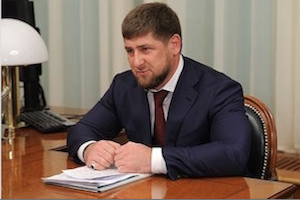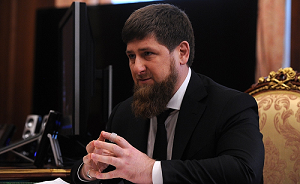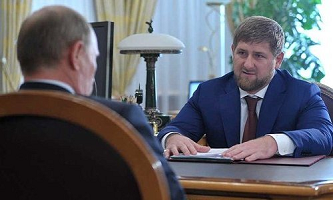Chechnya's Kadyrov Appoints Relatives to Top Jobs Amid Sanctions
By Huseyn Aliyev
February 6, 2018, the CACI Analyst
On December 20, 2017, the Head of Chechen Republic Ramzan Kadyrov was placed on the list of individuals sanctioned under the Magnitsky Act. The sanctions were introduced amid growing repression of dissent and the rapid replacement of top government officials with members of Kadyrov’s clan and family. Kadyrov’s own recent statement about his desire to retire suggests that the Chechen leader seeks to strengthen the influence of his family and clan in the republic’s government, enabling him to take a less formal (albeit similarly powerful) role should such a necessity arise in the future. The revival of the home-grown insurgency this year poses a new threat to the stability of Kadyrov’s regime, which will likely be met with increased repression.

Anti-Kadyrov Chechens are Targeted in Ukraine
By Huseyn Aliyev
December 11, 2017, the CACI Analyst
The recent assassination of anti-Moscow Chechen activist Amina Okueva in Kyiv is yet another link in the chain of targeted killings of Chechen President Ramzan Kadyrov’s opponents across the former Soviet Union and beyond. A former member of “Djokhar Dudayev” battalion, which fought against pro-Russian separatists in Eastern Ukraine, Okueva has been a target of pro-Kadyrov Chechens since her engagement in armed conflict in Ukraine. The event demonstrates Kadyrov’s capacity to persistently hunt down his enemies well outside the borders of Russian Federation. The inability and unwillingness of Ukrainian security services to protect Chechen volunteers, who participated in the campaign against Russian aggression in Donbas, leaves them vulnerable to persecution by Kadyrov’s associates.

Kadyrov, Moscow and Rohingya
By Emil A. Souleimanov & Huseyn Aliyev
October 24, 2017, the CACI Analyst
In late August, Chechnya’s ruler Ramzan Kadyrov issued several statements on his Instagram profile appealing to fellow Muslims to support publicly the case of persecuted Myanmar (Burmese) Muslims, Rohingya, while prompting Russian authorities to take an international stand on their behalf. Shortly thereafter, unapproved mass demonstrations, inspired or organized by Kadyrov, took place in downtown Moscow and Grozny, during which siloviki treated protesters unexpectedly gently. Kadyrov went so far as to make a controversial statement challenging Russia’s international stance on the issue. Kadyrov soon softened his tone, yet his appeals were unprecedented – even by the standards of Chechnya’s strongman. They outraged many in Russia, pointing to Kadyrov’s impunity not only for actions on the domestic and federal scenes, but increasingly also for meddling in Russia’s international affairs.

Attacks in Chechnya Suggest Opposition to Kadyrov is Far from Eradicated
By Emil Souleimanov
March 24, 2017, the CACI Analyst
At the turn of 2016 and 2017, events took place in parts of Chechnya that again challenged the triumphant statements of local pro-Moscow and federal authorities that the jihadist-inspired insurgency in this North Caucasian republic was eradicated. Aside from illustrating the latent character of armed conflict in the region in general and in Chechnya in particular, the recent upsurge of violence in Chechnya contains particularities that may have far-reaching consequences. Sporadic attacks against the Kadyrov regime will likely recur in the years to come and intensify should the regime’s grip on power weaken. 
The Kremlin’s Last Resort: Kadyrovtsi in Russia’s National Guard
By Dmitry Shlapentokh
March 3, 2017, the CACI Analyst
Russia’s economic condition remains precarious, mostly due to low oil prices, whereas Western sanctions have created additional problems. There are so far few signs of public discontent and Putin’s approval ratings remain high. Yet the Russian leadership apparently does not exclude the possibility of mass protests similar to those erupting in early 2012, which could spread and create a problem for the regime. In response to this possible scenario, Putin announced the creation of a National Guard in April 2016, a process that should be completed in 2017. The National Guard incorporated Chechen forces loyal to Ramzan Kadyrov, which could be deployed by the regime as a last resort.





